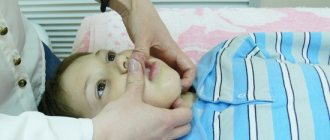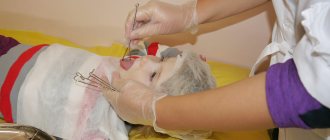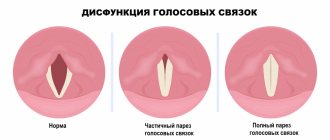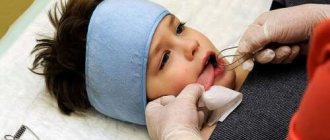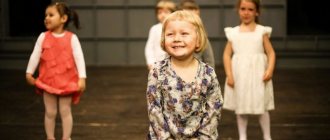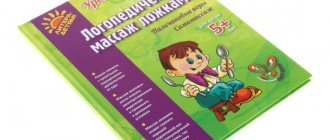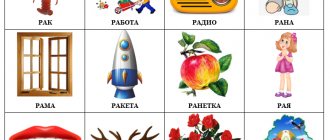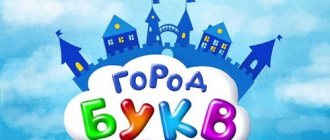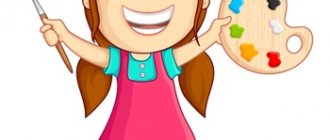Massage and gymnastics during the first year of a child’s life are a special moment in his physical development. And here, probably, we should make an “important discovery”: man is a holistic being! And there is neither an organ nor a cell in it that would work on its own, without interacting with each other. Therefore, by developing a child physically, we thereby influence his nervous system and contribute to mental development. In medicine, this is what they call psycho-motor development. Thus, by developing a child’s palm and fingers (fine motor skills), we provide a powerful stimulus to the development of the brain.
All our skills: the ability to think, learn, work, participate in ostrich racing, etc., all the many distinctive features that each of us possesses, is based on only two things - heredity and environmental characteristics.
Heredity is a parameter that medicine is only trying to influence; unfortunately, it is practically independent of our efforts. But the environment is a factor that can change depending on our desires and deeds.
And how we organize the “life” of a child, what kind of environment we create around him, will subsequently allow or not certain natural inclinations to develop.
It is not for nothing that the first 1000 days are called the “golden window of opportunity”, when the most ground for skills is laid: the first 280 days of the intrauterine period and 720 days of extrauterine life (the first 2 years of a child’s life).
What is differentiated massage?
Massage can be performed in different ways: tonic, relaxing, drainage, differentiated, etc. Each variety has its own tasks. It is not always the case that just one type is carried out; basically, the procedure is a combination of types and techniques aimed at one goal. Differentiated massage is a combination of techniques aimed at solving at least two problems, eliminating plus and minus symptoms. Let me explain with an example. With scoliosis, muscle tone is distributed unevenly, there are areas with weak muscles, there are areas with hypertonicity, and they are simultaneously located on the back. It is impossible to strengthen or relax the back in general, in the same way for all muscles, because this will lead to an increase in one of the symptoms. In order to relax tense areas and tone the weakened areas adjacent to them, a differentiated massage is performed. Simply put, this is a local effect on muscles located in the same massaged area, but with different strength and frequency. If there is poor posture or scoliosis, areas with increased tone can be located along the spine in a checkerboard pattern, alternating with areas with decreased tone. So, for example, massaging the lower back with tone on the right we relax, we tone on the left, then we tone the lower and mid-thoracic region on the right, we relax on the left, then we relax the upper thoracic and shoulder girdle again on the right on the left, we tone, this can also include the gluteal region and neck, according to the same principle.
Goals of speech therapy tongue massage
This procedure performs the following tasks.
- ✪ Stimulation of speech in case of delayed intellectual development of a child.
- ✪ Reducing increased salivation.
- ✪ Reducing the increased tone of the muscles that are involved in articulation.
- ✪ Activation of muscle tissue that has insufficient contractility.
- ✪ Improved kinesthetic sensations.
- ✪ Creation of suitable conditions for the development of voluntary movements of the articulation apparatus.
- ✪ Improving the elasticity of muscle fibers.
Speech therapy tongue massage for children is effective even with severe speech disorders. With its help, you can correct the pronunciation of sounds, improve sound clarity, and normalize the tone of the muscles responsible for the speech apparatus. Even if the patient has pronounced neurological symptoms, the use of competent massage can give good results.
Differentiated massage for a child
Doctors often prescribe general differentiated massage number 10 or 15 for children under one year of age, which puzzles parents. Not only does it have a number, like a diet, it also has a name. The number is the number of sessions, and differentiated is a characteristic note for the children's massage therapist with whom this procedure needs to be carried out. This massage is not recommended for mothers to do themselves; it requires certain knowledge. No online courses will teach you this if you don’t have basic medical education. Children's differentiated massage for infants represents the application of the same principles as described above, only on a whole-body scale. Babies under one year old always receive a general massage and areas with decreased and increased tone are more often in the limbs, a difference in tone between the right and left half of the body, more tense arms or vice versa legs, etc. Each child is a new individual set of characteristics of the neuromuscular and other systems. It’s only at first glance that newborns are similar, but when you start to conduct an examination, then each one has moments that do not always constitute a diagnosis and require the attention of a massage therapist. Clenched fists, curled toes, asymmetry of torso tone when lying like a banana, habitual head rotation, tension in the muscles of the shoulder blades, hips, weakness of the shoulder girdle, etc. There are a lot of such symptoms and they can be present in a child in varying quantities and mixed up. All this needs to be identified and worked with correctly. To bring the totality of similar symptoms in a child back to normal, a differentiated massage is performed.
Conditions for speech therapy tongue massage
The doctor's office should be warm and comfortable enough. The specialist’s hands must be warm and immaculately clean, and his nails must be cut short. The optimal time for massage is two hours after eating. Before the procedure, the child’s mouth must be thoroughly cleaned.
The approximate number of sessions is 20. The exact number is determined by the speech therapist, depending on the severity of the speech defect. To achieve maximum effect, the procedure is carried out every day. The duration of the session varies from 5 to 25 minutes, depending on the severity of the disorder.
Before starting the session, it is important for the patient to take the correct and most comfortable position. Here are the most optimal positions for the procedure.
- ✪ The child lies on his back, a special cushion or small pillow is placed under his neck. In this case, the head should be fixed and slightly tilted back.
- ✪ There is another option - the child simply sits in a chair that has a high headrest (this is a great way for those children who feel nervous when asked to lie down on the couch).
- ✪ During speech therapy massage, small children can be in a stroller in a half-sitting position, while their head should also be slightly tilted back.
- ✪ If a child is very afraid of various medical procedures, you can sit him on the parent’s lap.
During the massage, the patient must be in a calm state; pain and discomfort are not allowed. If a small patient is not in the mood for the procedure, in the first session you can limit yourself to light massaging movements in the facial area. It is acceptable to conduct sessions in the presence of parents if the child feels more relaxed when loved ones are nearby.
Immediately after the procedure, it is recommended to provide the child with complete rest for 15-20 minutes, after which he can go home and go about his daily activities. It is worth noting that even with the help of the most professional massage you cannot achieve an instant effect: the first results can only be noticed after a few weeks.
Indications for differentiated massage
Muscular dystonia (asymmetry, hypertonicity, hypotonicity), retardation in motor development, cerebral palsy, scoliosis, postural disorders, pyramidal insufficiency, etc.
General differentiated massage for infants is carried out with the same duration and frequency as restorative massage, but it differs in its content. I would like to once again draw the attention of parents that this procedure should be carried out by a professional and preferably experienced massage therapist. If the doctor indicated this type of massage, this indicates that there are certain problems that cannot be eliminated by simple stroking, etc. Unfortunately, sometimes parents try to do something themselves, but the child’s health is too important for everyone to experiment on him with their illusory ideas.
The effect of massage on the body
The nature of the effect of massage on the body is determined by the mechanisms of its action. The latter are divided into 3 types:
- Humoral . Skin receptors actively react to massage manipulations, as a result of which the body releases bioactive substances (acetylcholine, histamine, etc.). They are distributed through the bloodstream throughout all systems and contribute to the overall health of the patient.
- Nervous reflex . By performing certain actions, the massage therapist transfers his energy to the patient’s muscles, joints and skin. In the receptors of the latter, this energy is converted into a nerve impulse. It reaches the central nervous system, which begins to adjust the functioning of all other body systems.
- Mechanical . Direct impact on a specific area leads to increased blood circulation and lymph outflow. This mechanism has an excellent effect on the functioning of the heart and blood vessels, eliminates congestion in tissues, improves skin respiration and metabolism in general.
The first human organ that is positively affected by massage is the skin. The friction of the massage therapist's hands on the surface of the back, hips and other parts of the body causes a rush of blood to the surface of the epidermis and removes dead cells. Renewed skin absorbs oxygen better. The cells of the deep layer - the dermis - function more actively.
Massage strengthens the skin, stabilizes the sebaceous glands, as well as metabolism in superficial and deep tissues. The skin becomes elastic and toned. With more vigorous exposure, the tone of muscles and ligaments increases. Activation of blood circulation has a positive effect on the condition of all parts of the body.
Rules of application
Before deciding on a course of therapeutic massage, you should definitely consult with your doctor. You cannot “prescribe” such treatment for yourself. If used incorrectly, even massage can cause significant harm to the body.
The second rule concerns the duration of treatment. One massage session, even from the most highly qualified specialist, cannot bring the expected benefits. Illnesses and pain cannot disappear instantly. For this reason, real therapeutic massage is always prescribed in courses (10-15 procedures).
The number and frequency of sessions is determined by the doctor. It is imperative to follow his recommendations. In some cases, daily massage is required, in others - with breaks of 2-3 days. If the problem is severe enough, treatment may take several weeks.
Consultation with a doctor is also necessary because each patient requires an individual approach. There is no general treatment plan for everyone. When prescribing a course of therapeutic massage, the doctor takes into account the age, health status and specific disease of the patient.
Contraindications for therapeutic massage
No matter what magical properties therapeutic massage has, even it has contraindications. These include:
- the patient is feeling unwell;
- heat;
- acute respiratory infections;
- dermatological diseases (suppuration of the skin, fungal infections, etc.);
- incoagulability and other blood diseases;
- aneurysm;
- ischemic disease;
- tendency to bleed;
- thrombosis;
- varicose veins;
- cerebral vascular sclerosis;
- acute inflammatory processes of the lymphatic or circulatory system;
- atherosclerosis of peripheral vessels;
- allergies with skin reaction;
- tumors of any nature;
- chronic osteomyelitis;
- hypertensive crisis;
- Gastrointestinal disorders (diarrhea, vomiting);
- anemia;
- mental illness;
- syphilis in the active phase;
- tuberculosis and other highly infectious diseases.
Anyone who wants to improve their health with the help of therapeutic massage must not only take into account all the information presented in the article. It is important to find “your” specialist. The massage therapist must be highly qualified and have a medical education. You can even ask if there is any documentary evidence of this.
For many patients, it is also important that the specialist inspires confidence and is relatable. If something repels a person and causes a feeling of constraint, a massage is unlikely to be beneficial.
Execution Sequence
Relaxing the muscles of the neck and shoulder girdle
- We stroke the neck with both hands, moving from top to bottom.
- We rotate the child's head clockwise and counterclockwise, holding the back of the neck with one hand, and placing the other hand on the fronto-parietal part.
- We tilt the child's head back and forth, left and right.
Relaxing facial muscles
- At the same time, use the fingertips of both hands to make stroking movements 7-10 times:
- to the temples from the center of the forehead;
- to eyebrow hair;
- around the eyes in different directions;
- to the temples from the bridge of the nose, running your fingers under the lower eyelids;
- to the ears from the corners of the lips;
- on the forehead, cheeks, chin and neck;
- to the earlobes from the wings of the nose.
- Lightly pinch the edges of the lower jaw;
- We press with the pads of all fingers on the face from the roots of the hair to the chin.
Relaxing the lip muscles
- With your mouth closed or slightly open, stroke the upper and lower lips from the corners to the middle, and trace the lips with your fingers.
- We pass along the nasolabial folds from top to bottom.
- Tap the area around the lips clockwise.
Relaxing the muscles of the tongue
- To relax the root of the tongue, first perform the following exercises:
- massage the extreme points of the lower jaw;
- massage the submandibular fossa;
- move the tongue to the right and left, then forward and backward, grabbing its tip with your hand.
- With our left hand we hold the tongue outside the mouth through a gauze napkin or a clean handkerchief, with our right hand we perform massage movements with our fingers in pharmaceutical rubber gloves, a soft toothbrush or special massage speech therapy probes:
- We perform relaxing stroking movements from the tip to the root of the tongue along, across, on the sides, in circles;
- pat the tongue and press on it;
- turn and lightly pull the tongue to the right, then to the left.
Wellness (hygienic) massage
Wellness (hygienic) massage is very popular in medicine. It is used to prevent prostatitis, as well as many other diseases. When treating it, the traditional method of general massage is performed. Deep kneading techniques and strong rubbing concentrate on the lower back and legs. The stomach and arms are massaged quite easily. The collar area and head are warmed up when the patient takes a sitting position. In a horizontal position of the patient (lying on his stomach), segmental massage is performed. First of all, the massage therapist kneads the patient's back, pelvic area (stroking, rubbing, kneading) and the sacrum (stroking and rubbing techniques are performed from the outer edge of the sacrum to the inner ridge). After this, the muscles along the outer edge of the sacrum are massaged, then the gluteal muscles. Minor vibrations over the symphysis are performed with increased tone. The session ends with shaking the back and pelvis. Kneading the lower abdomen and pubic symphysis helps relieve bladder pain. Testicular massage is performed in order to reduce pain, swelling, improve lymph flow, and increase the tone of the vessels that make up the spermatic cord. To quickly improve the condition, the procedure should be carried out from the moment of injury. First of all, the spermatic cord is massaged.
Execution Sequence
Activating facial muscles
- At the same time, use the fingertips of both hands to make stroking and rubbing movements 7-10 times:
- to the temples from the center of the forehead;
- to eyebrow hair;
- on the eyebrows;
- around eyes;
- along the cheeks from the wings of the nose to the ears and from the chin to the ears.
- We rhythmically squeeze our chin.
- We knead the cheekbones and cheeks with spiral movements.
- Rub the cheeks by placing the index finger in the mouth and the thumb on the cheek.
- We pinch our cheeks.
Activating the lip muscles
- With your mouth closed or slightly open, stroke the upper and lower lips from the corners to the middle.
- We pinch the skin around the lips.
- Tap vigorously around the lips.
Activating the muscles of the tongue
- When activating a tongue massage, the movements are intense, directed from the root to the tip, mainly using rubbing and kneading techniques:
- rub the tongue with your fingers along, across, in a spiral from top to bottom.
- squeeze the sides.
- pinch the edges.
- pat the top with a spatula or toothbrush.
- We vibrate the tip of the tongue using a wooden spatula.
We activate the muscles of the neck and shoulder girdle
- We rub the side surface of the neck from bottom to top to the corners of the lower jaw.
- We rub the posterolateral surface of the neck from bottom to top from the shoulder blades to the back of the head.
- We ask the child to turn his head back and forth to the right and left, while simultaneously counteracting these movements with his hand.
